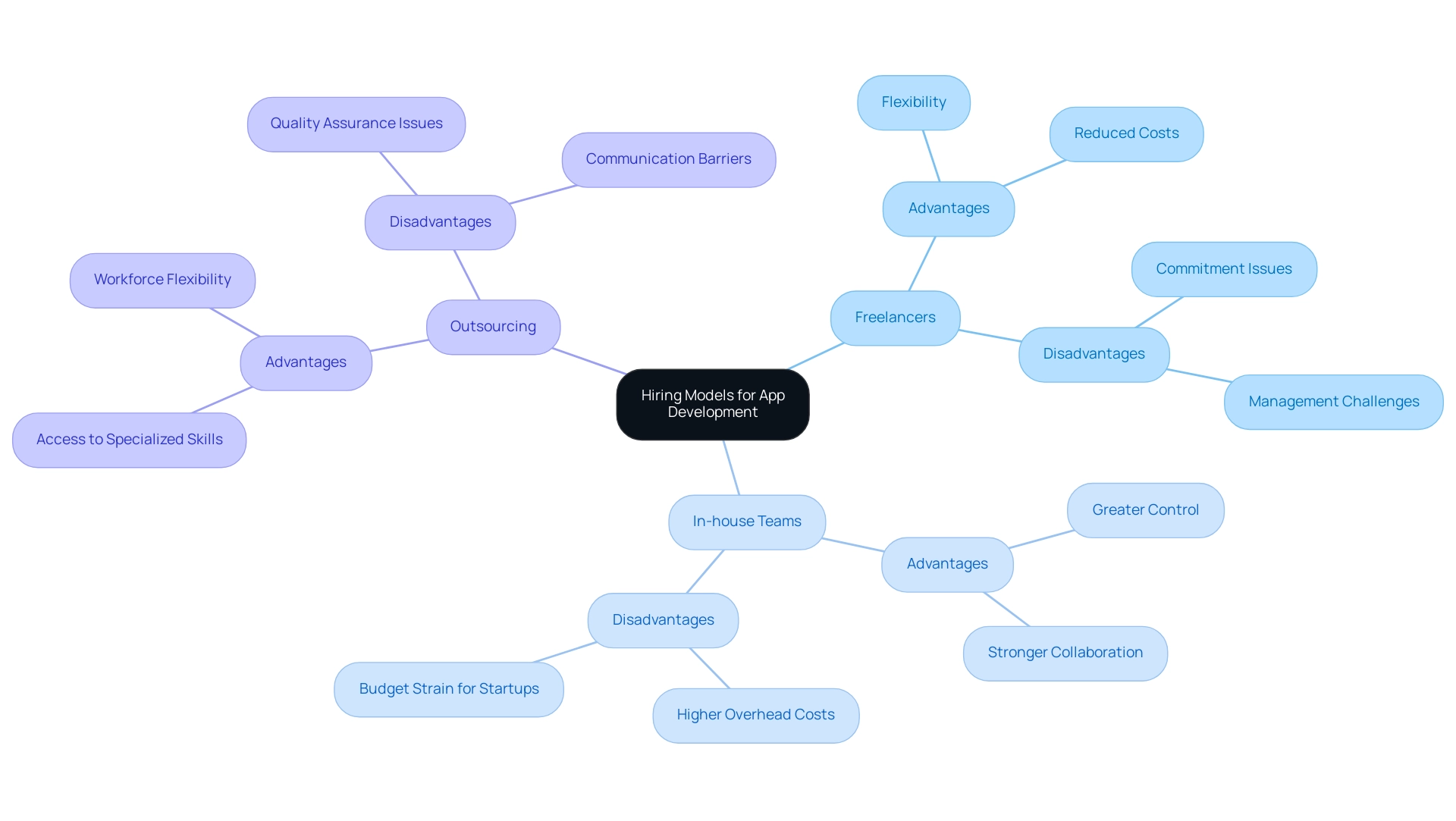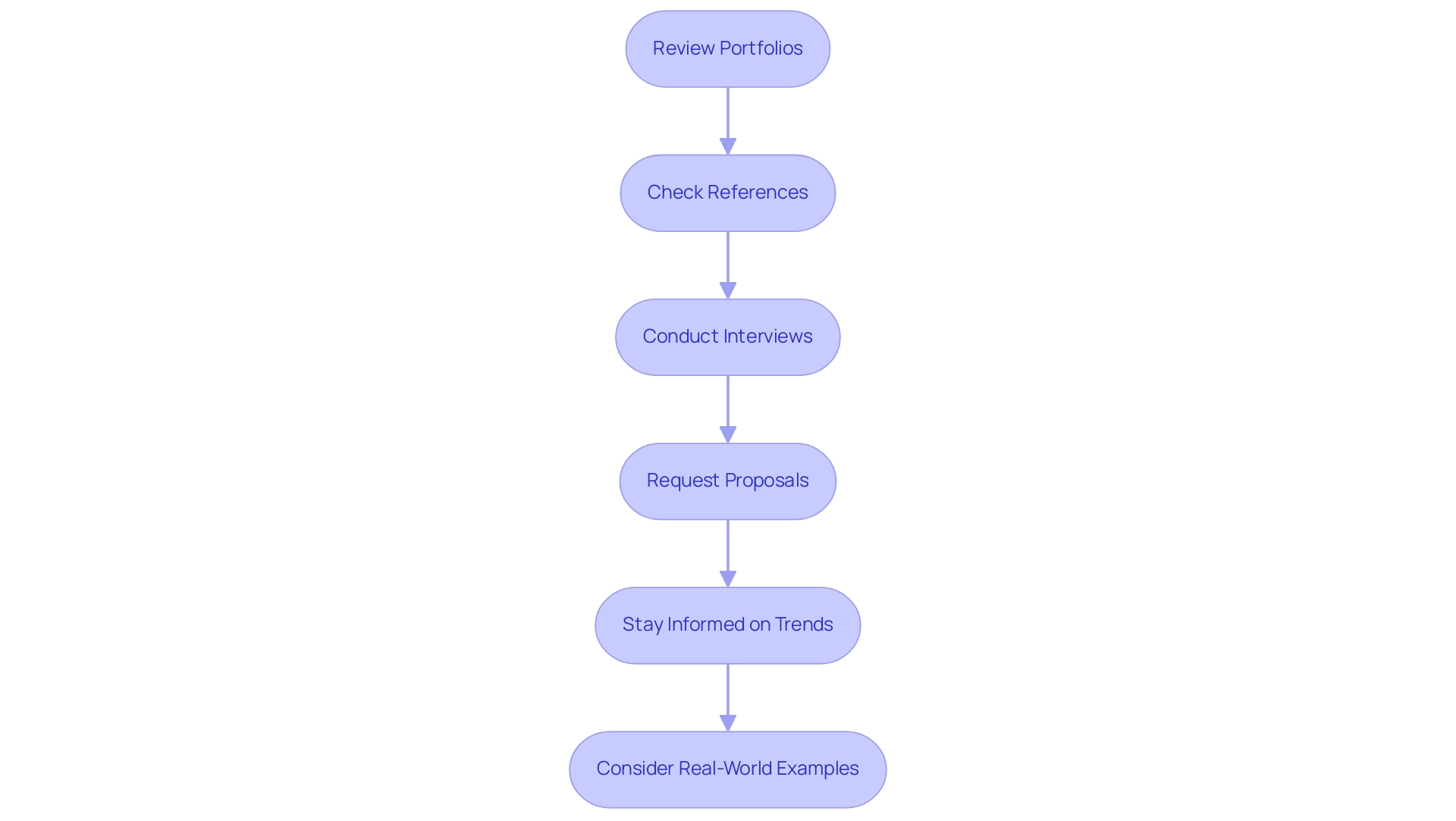Introduction
In the competitive landscape of mobile app development, establishing a clear vision from the outset is paramount. As businesses strive to create impactful applications, understanding the goals and objectives that guide this process becomes essential. From identifying the target audience to determining the necessary features for user satisfaction, each decision shapes the app's trajectory.
Furthermore, as technological advancements continue to reshape the industry, selecting the right hiring model and developer can significantly influence project outcomes. This article delves into the critical steps for:
- Defining app goals
- Exploring hiring options
- Evaluating developers
- Budgeting effectively
- Ensuring robust communication within development teams
By following these guidelines, organizations can navigate the complexities of app development and position themselves for success in a rapidly evolving market.
Defining Your Mobile App Goals and Objectives
To initiate a successful mobile app creation journey, begin by clearly identifying its primary purpose. Ask yourself critical questions:
1. What specific problem does the app resolve?
2. Who constitutes the target audience?
What features are vital for ensuring user satisfaction? Documenting these goals is essential, as they will serve as a guiding reference throughout your growth process. Engaging stakeholders in these discussions is equally important; their diverse perspectives will contribute to a well-rounded grasp of the app's objectives, ultimately enhancing its effectiveness.
As the expert from Kissflow stated, "The beauty of Kissflow is how quick and easy it is to create the apps I need. It's so user-friendly that I created precisely what I required in 30 minutes," highlighting the value of user-friendly tools. Furthermore, understanding security and data privacy is critical, especially in sectors like healthcare and finance, where sensitive information is involved.
According to ToolbarStudio Inc.'s privacy policy, the types of Personally Identifiable Information collected include:
- Names
- Addresses
- Email addresses
All of which are securely stored and accessible only to authorized personnel. This emphasizes the importance of robust data handling practices. Considering that the average smartphone user interacts with approximately 6.65 apps weekly, establishing clear objectives can help your app stand out in this competitive environment.
Moreover, with Gartner predicting that by 2025, 95 percent of apps will be cloud-based, aligning your app goals with current trends will bolster its relevance and usability in the evolving marketplace. Innovative opportunities, such as those presented by blockchain and wearables, also highlight the need for clear objectives that can adapt to emerging technologies.

Exploring Different Hiring Models for App Development
When considering to hire mobile apps developer for mobile app development, it’s crucial to evaluate their respective advantages and disadvantages to determine the best fit for your business needs.
- Freelancers: Frequently the preferred option for small-scale assignments or specialized tasks, freelancers offer flexibility and usually reduced costs.
However, a potential drawback is their level of commitment, which may not match that of an in-house group. Success stories of brands that choose to hire mobile apps developer effectively illustrate their potential when freelancers are managed well, particularly for short-term projects.
- In-house Teams: For long-term efforts that require ongoing support, in-house teams are generally more advantageous.
They offer greater control over the development process and foster stronger collaboration. That said, they come with higher overhead costs, which can strain budgets, especially for startups or smaller enterprises. Additionally, with the increasing emphasis on pay transparency in job listings and hiring processes, companies must be mindful of compensation expectations to attract and retain talent.
- Outsourcing: This model is particularly advantageous for larger tasks, as it allows access to specialized skills that might not be available in-house.
However, managing remote groups can present challenges, including communication barriers and quality assurance issues. As Robert Half noted, with 90% of tech hiring managers facing difficulties in finding skilled candidates, outsourcing has become an increasingly attractive solution to fill critical roles while maintaining workforce flexibility.
Moreover, understanding security threats and data privacy regulations is essential, especially given the growing reliance on mobile apps in sensitive sectors like healthcare and finance, as highlighted in our case study on security and data privacy in mobile apps, which may lead you to hire mobile apps developer.
Ultimately, the choice between freelancers, in-house teams, and outsourcing hinges on your project scope, budget constraints, and the specific skill sets required. For instance, Hanny Q.'s satisfaction with the Food Delivery solution for their online food business illustrates how effective hiring models can lead to successful app creation outcomes.
Understanding these dynamics not only aids in decision-making but also aligns your development efforts with broader industry trends, such as the increasing focus on security and data privacy in mobile applications.

Evaluating and Selecting the Right Mobile App Developer
Evaluating potential mobile apps developer is crucial for ensuring the success of your business solution, especially in a rapidly expanding market projected to reach $8.1 trillion by 2026. Here are key steps to follow:
- Review Portfolios: Scrutinize the developer's previous work to gauge their design style and technical expertise.
In 2021 alone, a staggering 2 million new applications were created, underscoring the importance of a strong portfolio in a competitive market. Look for evidence of tailored solutions that have improved key performance indicators (KPIs) for clients, including retention rates, Average Order Value (AOV), and Lifetime Value (LTV).
- Check References: Engage with former clients to gain insights into their experiences and satisfaction levels with the developer’s work.
This can provide valuable context about the developer's reliability and communication skills, particularly in delivering solutions that resonate with community needs.
- Conduct Interviews: Develop a set of targeted questions that assess both technical capabilities and cultural compatibility. Discuss your objectives to measure their enthusiasm and understanding of your unique needs, which is critical for fostering a collaborative environment.
Seek developers who demonstrate an understanding of how to build community value through their solutions.
-
Request Proposals: Solicit detailed project proposals that clearly outline timelines, deliverables, and methodologies. This will enable you to make effective comparisons between potential developers, ensuring their approach aligns with your business objectives and past success in generating incremental revenue.
-
Stay Informed on Trends: Keep abreast of recent advancements in app technology, such as the rise of AI agents, as highlighted in the A3Logics guide. Understanding these trends can inform your selection process and ensure the developer is equipped to leverage the latest advancements, enhancing the value of your custom solutions.
-
Consider Real-World Examples: Reference case studies, such as the advancements in health and wellness apps accelerated by the pandemic, which illustrate how app creation has evolved.
This context can help you identify adaptable and innovative developers, especially those you might consider to hire mobile apps developers, reflecting over 20 years of proven experience in the industry, particularly in sectors that align with your business goals. By following these steps, you can effectively evaluate mobile app developers and select a partner who can contribute to your e-commerce success in a rapidly evolving market, ultimately enhancing your KPIs and driving incremental revenue.

Budgeting for Mobile App Development: Costs and Considerations
When budgeting for mobile app creation, several critical factors must be considered to ensure a successful project:
- Development Costs: Familiarize yourself with the average costs associated with various platforms. In 2024, the cost of creating an iOS app tends to be higher than that of an Android app, primarily due to the additional design and production standards required by Apple. Understanding these differences and the complexity of the desired features is essential for accurate budgeting. It's important to note that the final cost of app creation can vary due to multiple influencing factors, making it difficult to provide a precise estimate.
- Ongoing Maintenance: Maintenance is an ongoing commitment that encompasses essential tasks such as bug fixing, security updates, performance monitoring, and user support. Allocate a budget that allows for these continuous improvements, with estimates suggesting that businesses should prepare for up to $1,800 of their app-building cost for the deployment step.
- Marketing Budget: Post-launch visibility is critical for user acquisition. Set aside a dedicated marketing budget to promote your app effectively. This may include costs for advertising, social media campaigns, and other promotional activities.
Creating a detailed budget plan will not only help manage expectations but also prevent overspending. As Nikhil Khandelwal, VP of Engineering, emphasizes,
We believe in transparent communication and will explain how various project choices impact the budget.
Furthermore, using app creation cost calculators like those from Cleveroad, Buildfire, and Inoxoft can offer customized estimates based on your app's particular needs and features. Each of these calculators offers unique approaches to estimating costs, taking into account app features and complexity, which can further enhance your budgeting strategy.

Ensuring Effective Communication with Your Development Team
Effective communication is essential for the success of your app creation group. Here are key strategies to implement:
- Establish Clear Channels: Utilize communication platforms such as Slack or Trello to facilitate transparency and ensure all members are aligned on objectives and updates.
According to recent data, these platforms rank among the most favored by programmers, with Slack being used in about 30% of app creation projects. This reflects their effectiveness in streamlining communication.
- Schedule Regular Check-ins: Implement weekly or bi-weekly meetings to assess progress, address challenges, and outline the next steps in the project process.
Regular check-ins have been demonstrated to greatly influence app creation success by offering a structured chance for group members to share insights and report on their progress. Leveraging cloud technology during these meetings can further enhance app scalability, user experience, and responsiveness.
- Encourage Feedback: Foster an environment where group members feel empowered to voice their ideas and concerns.
As Khalid Abuhakmeh, a .NET Developer Advocate, emphasizes, the software creation industry has, unfortunately, failed thus far with gender diversity, excluding meaningful perspectives from contributing to the creative process. I hope for a future where we can do better.
By promoting open dialogue, you not only enhance collaboration but also spark innovation, ultimately leading to more successful app outcomes. For instance, the development of new types of wearables, such as smart rings and AR glasses, showcases how effective communication can lead to innovative solutions that enhance health monitoring capabilities.
Incorporating these strategies will enhance team cohesion and drive the development process toward achieving your business objectives.

Conclusion
A successful mobile app development journey starts with a clear vision that defines goals and objectives. By identifying the app's purpose and understanding the target audience, businesses can create applications that effectively meet user needs and differentiate themselves in a competitive market. Engaging stakeholders during this phase enhances collaboration and overall user satisfaction.
Choosing the right hiring model is equally important. Whether opting for freelancers, in-house teams, or outsourcing, organizations must assess their project requirements and budget constraints. Each option has distinct advantages and challenges that can significantly affect development outcomes. Evaluating potential developers through portfolios and references ensures alignment with business objectives.
Budgeting is another critical aspect. Understanding costs associated with different platforms, ongoing maintenance, and marketing is essential for managing expectations and avoiding overspending. A detailed budget can help maximize return on investment.
Effective communication within development teams is vital for success. Establishing clear channels, scheduling regular check-ins, and encouraging feedback foster collaboration and drive innovation.
In summary, navigating mobile app development complexities requires strategic planning focused on clear goals, appropriate hiring practices, diligent budgeting, and strong communication. Following these principles positions organizations for success in creating impactful applications that resonate with users and adapt to the ever-evolving technological landscape.





